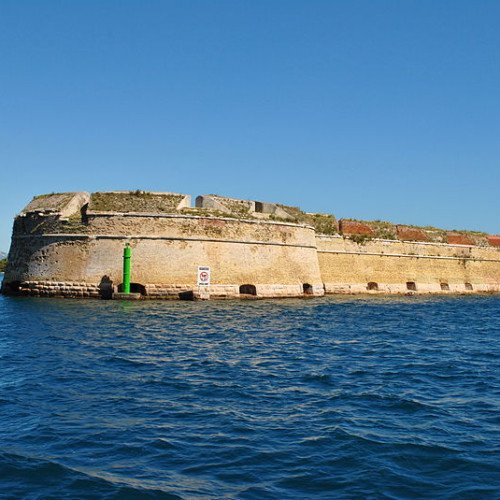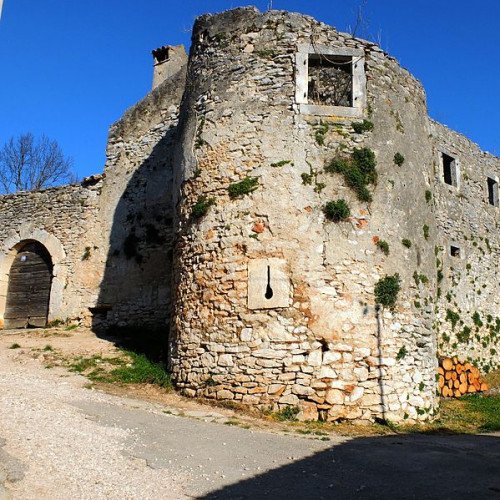Castles of "Croatia" ST. NICHOLAS FORTRESS vs ŠUMBER

ST. NICHOLAS FORTRESS
St. Nicholas Fortress (Croatian: Tvrđava sv. Nikole) is a fortress located at the entrance to St. Anthony Channel, near the town of Šibenik in central Dalmatia, Croatia. It was included in UNESCO's World Heritage Site list as part of "Venetian Works of Defence between 15th and 17th centuries: Stato da Terra – western Stato da mar" in 2017. After reconstruction work that lasted for two years, the fortress was open to visitors in July 2019. The town of Šibenik has a fortification system consisting of four fortresses: St. Nicholas Fortress (Tvrđava sv. Nikole) St. Michael's Fortress (Tvrđava sv. Mihovila) St. John's Fortress (Tvrđava sv. Ivana) Barone Fortress (Tvrđava Barone) Only St. Nicholas Fortress is at sea, at the entrance to the Šibenik port, and the remaining three are on land. St. Nicholas Fortress was built on the left side at the entrance to St. Anthony Channel, on the island called Ljuljevac. The island is situated at the entrance to the Šibenik channel across the Jadrija beach lighthouse. St. Nicholas Fortress got its name from the Benedictine Monastery of St. Nicholas, which was originally on the island, but due to the construction of the fortress, it had to be demolished. At the request of domestic Croat population of Šibenik, the Venetian captain Alvise Canal decided to build a fort on the island of Ljuljevac on 30 April 1525. The fortress was designed and built by the famous Venetian architect and builder Giangirolamo Sanmicheli (nephew of Michele Sanmicheli). It was built by in the 16th century to prevent Turkish boats from reaching the port. St. Nicholas Fortress was armed with 32 cannons. However, its imposing appearance and size were a bigger threat to the enemy than cannons ever were.
Statistics for this Xoptio

ŠUMBER
Šumber (Italian: Sumber, Sumberg, Casali Sumberesi) is a village and ruinous castle in the eastern part of Istria County, Croatia, in the municipality of Sveta Nedelja. In 2011, the population of the village is 381. It is in the eastern part of Istria, on the local road L50123, 5 kilometres (3 mi) north-west from the village and municipal center Nedešćina, 10 kilometres (6 mi) from Labin, and 8 kilometres (5 mi) west of Kršan. The castle was built at the site of the prehistoric hillfort in the former village Stari Grad (Old Town). The site was first mentioned in documents in 872, and in 950 when Byzantine Emperor Constantine VII Porfirogenet confirmed the presence of Slavs in these villages. In 1260, has passed into the possession of vassals of the Counts of Gorizia, the Austrian noble family Schönberg by which it got its name. Among the signatories of the peace treaty in 1274 between the Aquleia patriarch Raimondo della Torre and the Count of Gorizia Albert I, there was Teodorich de Sumberg. As a vassal of Gorizia Count Albert III, Dietrich von Schonberg in 1341 attack and plundered the countryside of Venetian Motovun. Since 1367, when counts of Gorizia became extinct, was inherited by Habsburg family and was part of the Pazin County. At the end of the 14th century, after the extinction of the family Schönberg and marriage of Anna Schönberg with Ivan Gutenegg, the lord of Kožljak, it was connected to Kožljak estate. In 1444, Anna sold the castle to the lords of Kršan, Juraj Kerstlein (Karscheyner). After Labin in 1420 came under Venetian rule, Šumber became a border fortress between the Austrian March of Istria, and Venetian part of Istria. In 1420 Venetians occupied it but they also accepted the offer of lord of Kršan to buy the village. Therefore, it was converted into a Renaissance castle by additions of corner round semi-tower. In the war between Emperor Maximilian and Venice in 1508, Gaspar Karscheyner lost Kršan and Šumber, but in 1509 they were returned. Gaspar repaired Kršan, but in 1515 sold Šumber to the family Herberstein, lords of Lupoglav. The Herberstein family ruled it only briefly as in 1525 exchanged it with Ferdinand I Habsburg for Reitberg. When Ferdinand became king of Croatia in 1527, he gave it to Senj and Klis captain Petar Kružić. After Kružić died in 1537, was inherited by his daughter Margareta, and with marriage, to Senj nobleman Ivan Sinković. As Sinković died in 1616 without male heirs, the inheritance have taken his daughters. At that time it was exposed to frequent Venetian attacks. Under the pretense that its lords are helping Uskoks (which was true, because many Uskoks really found refuge on the Istrian properties of Kružić and Sinković), in 1612 was devastated by the Venetian mercenaries. When the Uskoks attacked and plundered Plomin in 1614, Šumber was again exposed to Venetian devastation. At the beginning of Uskok War, 1616, Šumber again suffers Venetian attacks and looting, which ceased only in 1617. After the completion of the Uskok War in 1617, its defensive function was converted into a comfortable residence. In 1626 became the property of Prince Johann Ulrich von Eggenberg, whose son Anton in 1634 sold Šumber for 42,000 florins to Baron Pompeo II Brigido of Trieste, whose estate were around Lupoglav (i.e. Lupoglav, Šumber, Lesičina). This family continued to own the property until the end of feudalism in 1848. It's a small fortress with polygonal layout defended by two round half-towers in south-eastern and south-western part, next to which is on the west wall the main entrance to the fort. On the inner side of the southern wall are the remains of a long and narrow one-story palace, and another small house is located in the northeast corner of the castle. Although the castle is largely preserved, at least according to Valvasor views from 1680, the tower and the residential wings were much higher than they are today.